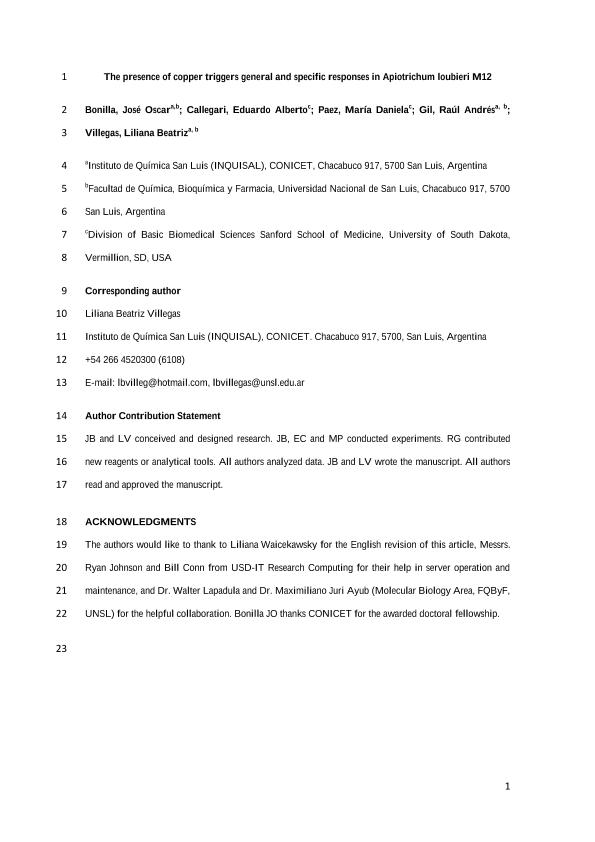Mostrar el registro sencillo del ítem
dc.contributor.author
Bonilla, José Oscar

dc.contributor.author
Callegari, Eduardo Alberto

dc.contributor.author
Paez, María Daniela
dc.contributor.author
Gil, Raul Andres

dc.contributor.author
Villegas, Liliana Beatriz

dc.date.available
2023-06-28T21:57:14Z
dc.date.issued
2022-12
dc.identifier.citation
Bonilla, José Oscar; Callegari, Eduardo Alberto; Paez, María Daniela; Gil, Raul Andres; Villegas, Liliana Beatriz; Bivalent copper ions presence triggers removal and homeostatic mechanisms in the metal-resistant microorganism Apiotrichum loubieri M12; Elsevier Science; Research In Microbiology; 174; 3; 12-2022
dc.identifier.issn
0923-2508
dc.identifier.uri
http://hdl.handle.net/11336/201753
dc.description.abstract
Microorganisms, especially those habiting mining environments, are of great importance for the retention of toxic metals in the environment. This work aimed to isolate a copper removing-microorganism from sediments of an Acid Mine Drainage-affected environment and to study the cellular responses trigger by metal presence. Apiotrichum loubieri M12 was able to tolerate and remove Cu(II) from liquid culture media, reaching a 30–35% removal capacity when it was exposed to 40 μg mL−1 Cu(II) after 48 h. Analysis of the biomass exposed to the metal through SEM-EDS showed copper presence on the cell surface and variations in the proportion of other biomass constituent elements. Proteomics revealed that the presence of Cu(II) induces differential expression of intracellular proteins involved in a wide variety of metabolic processes. Interestingly, a specific response to the metal was detected in cell-free supernatants, in which copper binding proteins were identified. A large number of proteins with metal ion binding sites were detected both at intra and extracellular levels. The microorganism responds not only by adjusting intracellular protein expression, but also by adjusting expression of proteins in the extracellular space.
dc.format
application/pdf
dc.language.iso
eng
dc.publisher
Elsevier Science

dc.rights
info:eu-repo/semantics/openAccess
dc.rights.uri
https://creativecommons.org/licenses/by-nc-sa/2.5/ar/
dc.subject
APIOTRICHUM
dc.subject
COPPER REMOVAL
dc.subject
PROTEOMICS
dc.subject
SEM-EDS
dc.subject.classification
Biología Celular, Microbiología

dc.subject.classification
Ciencias Biológicas

dc.subject.classification
CIENCIAS NATURALES Y EXACTAS

dc.title
Bivalent copper ions presence triggers removal and homeostatic mechanisms in the metal-resistant microorganism Apiotrichum loubieri M12
dc.type
info:eu-repo/semantics/article
dc.type
info:ar-repo/semantics/artículo
dc.type
info:eu-repo/semantics/publishedVersion
dc.date.updated
2023-06-21T20:37:47Z
dc.journal.volume
174
dc.journal.number
3
dc.journal.pais
Países Bajos

dc.journal.ciudad
Amsterdam
dc.description.fil
Fil: Bonilla, José Oscar. Consejo Nacional de Investigaciones Científicas y Técnicas. Centro Científico Tecnológico Conicet - San Luis. Instituto de Química de San Luis. Universidad Nacional de San Luis. Facultad de Química, Bioquímica y Farmacia. Instituto de Química de San Luis; Argentina
dc.description.fil
Fil: Callegari, Eduardo Alberto. University of South Dakota; Estados Unidos
dc.description.fil
Fil: Paez, María Daniela. University of South Dakota; Estados Unidos
dc.description.fil
Fil: Gil, Raul Andres. Consejo Nacional de Investigaciones Científicas y Técnicas. Centro Científico Tecnológico Conicet - San Luis. Instituto de Química de San Luis. Universidad Nacional de San Luis. Facultad de Química, Bioquímica y Farmacia. Instituto de Química de San Luis; Argentina
dc.description.fil
Fil: Villegas, Liliana Beatriz. Consejo Nacional de Investigaciones Científicas y Técnicas. Centro Científico Tecnológico Conicet - San Luis. Instituto de Química de San Luis. Universidad Nacional de San Luis. Facultad de Química, Bioquímica y Farmacia. Instituto de Química de San Luis; Argentina
dc.journal.title
Research In Microbiology

dc.relation.alternativeid
info:eu-repo/semantics/altIdentifier/doi/http://dx.doi.org/10.1016/j.resmic.2022.104013
dc.relation.alternativeid
info:eu-repo/semantics/altIdentifier/url/https://www.sciencedirect.com/science/article/abs/pii/S0923250822000948
Archivos asociados
